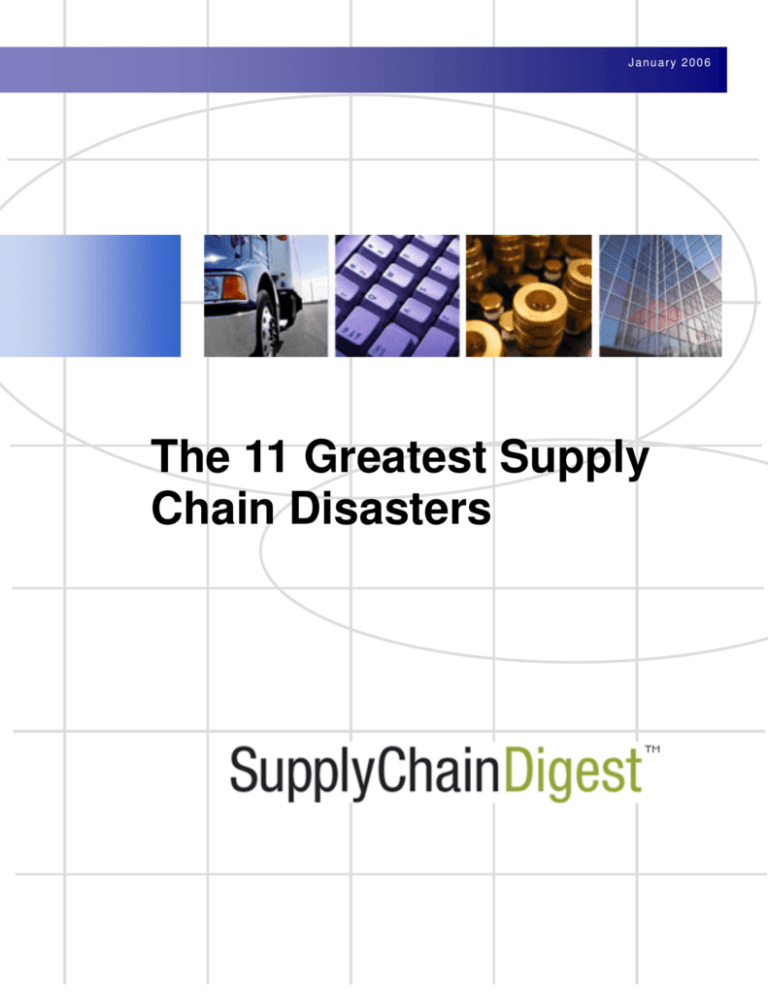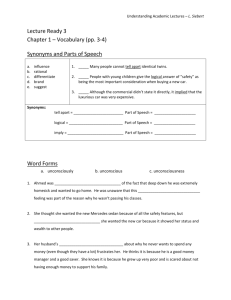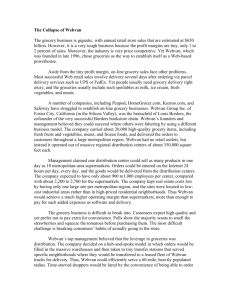
January 2006
The 11 Greatest Supply
Chain Disasters
Introduction
Many of us rightly take pride in the growing recognition role of supply chain both
within companies and in the public markets. An increasing number of companies
cite supply chain initiatives and prowess in annual reports and meetings with
financial analysts.
But of course the opposite effect must then also occur – supply chain snafus are
increasingly cited by CEOs and CFOs to explain poor financial performance.
Which got us thinking, what have been the greatest supply chain disasters we’ve
seen in the 20 years or so since that term started being used? SCDigest did a lot of
research to find out.
First, some caveats: we focused only on “man made” disasters, and so excluded
such things as Mother Nature and factories burning down, even though these often
evidence holes in supply chain strategy and risk reduction plans. Second, we
looked for examples that had a significant impact on the company in terms of
finances, stock price, brand equity, etc. Third, it’s still subjective, and we probably
missed a few “good” candidates.
Below you will find a summary table of our “Top 11,” ( weird number, yes, but we just
couldn’t find one to cut) in order from worst to not quite as worse, as well as more
detailed stories of the nature and impact of each disaster.
Interestingly, none of our Top 11 occurred after 2001. Coincidence? While at one
level we see more public attention to supply chain issues, it appears the lessons
from failures in the past have at least led companies to avoid the catastrophic
impacts.
1. Foxmeyer’s 1996 Distribution Disaster
In 1996, Foxmeyer was the second largest wholesale drug distributor in the U.S.,
with sales over $5 billion dollars in a highly competitive industry.
The disaster started with an ambitious project to revamp both its IT systems and
its distribution facilities. This involved a new ERP system, and a highly
automated DC in Ohio that relied on huge number of carousels for order picking
and conveyors for product movement.
The company was estimating huge efficiency gains from the new systems – so
much so that it started to bid future contracts based on the expected cost
reductions.
Not a smart move, it turns out.
1
SupplyChainDigest 2006 All Rights Reserved.
First, this was perhaps SAP’s first foray into the world of high volume distribution.
The system was unable to handle the volumes of orders. “We ran some
simulations,” said one company exec, “but not with the level of data we have in
an operating environment.”
Foxmeyer, for a myriad of reason, ignored many warning
signs. Said one consultant on the project, “Every time we
showed them something that didn’t work, they’d say ‘Is it a
deal breaker?’ Well, no one thing was a deal breaker. But
if you put enough cinder blocks in a rowboat, it’s going to
sink.”
Lights out
warehousing? Try
“lights out” Foxmeyer.
But the order processing system wasn’t the only issue. The DC automation
system also was a disaster. At the time, it was one of the most highly automated
facilities in the U.S.
Nothing much worked right. The automation controls had constant bugs, and
Foxmeyer had to deploy hundreds of workers to work around the issues. “The
underlying software would fail in the middle of the process, so we’d have to stop
and restart in the middle of intense picking hours,” said one logistics executive.
The whole thing snowballed between the combined system issues. An order
would be partially shipped due to DC problems. The customer would receive a
partial order, and call to complain. Unable to see the rest of the order had
shipped on a later truck, the customer service rep would authorize a replacement
shipment for product already on its way to the customer. Tens of millions of
dollars in unrecoverable shipping errors ensued. Add to that cost savings that
weren’t ever likely to materialize at the level Foxmeyer had assumed in bidding
some large new contracts, and it spelled total disaster.
Lights out warehousing? Try “lights out” for Foxmeyer.
After filing for bankruptcy, the main operating division of the $5 billion company
was sold to its larger rival, McKesson, for only $80 million. Last we knew, there
were still outstanding lawsuits working there way through the process between
Foxmeyer and several technology and consulting companies.
2
SupplyChainDigest 2006 All Rights Reserved.
Top Supply Chain Disasters
Rank
Company
Year(s)
Foxmeyer
Drug
1996
1
2
GM
1980s
3
4
5
6
7
WebVan
Adidas
Denver Airport
baggage
handling
system
2001
1996
1995
Toys R
Us.com
1999
Hershey
Foods
1999
8
Cisco
2001
9
Nike
2001
10
11
Aris Isotoner
Apple
1994
1995
Issue/Problems
New order management and
distribution systems don’t work,
and fulfillment cost targets built
into contracts are unattainable
CEO Robert Smith invests
billions in robot technology that
mostly doesn’t work
On-line grocer has many
problems, including massive
investment in automated
warehouses that drain capital
and aren’t justified by demand
New warehouse system –
actually, first one then another –
and DC automation just don’t
work
Complex, hugely expensive
automated handling system
never really works
Can’t fulfill thousands of orders
for which it promises delivery by
Christmas
Order management and
warehouse implementation
issues cause Hershey to miss
critical Halloween shipments
Lacking adequate demand and
inventory visibility, Cisco is
caught with piles of product as
demand slows
Trouble with new planning
system causes inventory and
orders woes
Division of Sara Lee makes
disastrous decision to move
production from Manila to even
lower cost countries; cost rise
instead as quality plummets
Playing a conservative
inventory strategy, Apple is
swamped with demand for new
Power Macs and can’t deliver
the goods
Source: SupplyChainDigest
3
SupplyChainDigest 2006 All Rights Reserved.
Impact/Result
Huge sales losses; Foxmeyer files
for bankruptcy, and is eventually
bought by McKesson
Smith fired; Low tech Toyota uses
lean manufacturing to gain strong
competitive advantage as GM’s
market share heads south
Company goes from billions in
market cap to bankrupt in a matter
of months
Company under-ships by 80% in
January; incurs market share losses
that persist for years
Airport opens late; huge PR fiasco;
system is only minimally used from
start and shuttered totally in 2005
Famous “we’re sorry” emails 2 days
before Christmas cause fire storm
of negative PR; eventually
outsources fulfillment to
Amazon.com
Company says at least $150 million
in revenue lost; profit drops 19%,
and stock goes from 57 to 38
Company takes $2.2 billion
inventory write-down; stock drops
50% and has stayed near that level
since
Nike blames software related issues
for $100 million dollar revenue
shortfall for the quarter; stock drops
20%
Sales are cut by 50%; company
goes from strong profit to big
losses; Sara Lee soon sells
Isotoner unit to Totes
Apple takes PR black eye and loses
PC market share, which it never
really recovers
2. GM’s Robot Mania
General Motor’s CEO in the 1980s was Roger Smith, of “Roger and Me” fame,
the documentary that really launched the career of liberal filmmaker Michael
Moore.
Smith was fascinated with technology. Among other
projects, such as the purchase of IT firm EDS, Smith
embarked on a very aggressive effort to implement robots
in GM factories.
When Smith was appointed, GM had approximately 300
robots of one kind of another. He soon created a joint
venture with Japan’s robot designer Fujitsu-Fanuc, and
said he planned to deploy 14,000 new robots in GM plants
by 1990.
As one GM finance
executive later noted, at
the time the company
could have bought both
Toyota and Nissan for
the money invested in
the failed robot
technology
Bad move.
Costing billions of dollars, the robots never really worked. As one observer wrote,
“The robots accidentally painted themselves and dropped windshields on to front
seats.”
A “show place” factory in Hamtranck, MI turned out to be more like a “basket
case.” Introduction of the robots lowered productivity. A nearby Mazda plant
produced just as many vehicles, with 1,500 fewer employees.
The entire project was later largely scrapped, as GM’s costs rose and market
share shrunk. Meanwhile, Toyota delivered low cost, high quality vehicles using
comparatively low tech “lean production” techniques.
As one GM finance executive later noted, at the time the company could have
bought both Toyota and Nissan for the money invested in the failed robot
technology, a point especially painful given GM’s troubles and Toyota and
Nissan’s success today.
3. The WebVan Story
Though the spectacular rise and fall of on-line grocer WebVan was hardly only a
supply chain story, its decision to invest huge sums in highly automated
warehouses was certainly a strong contributor to that fall, and today seems
almost ludicrous in its concept.
4
SupplyChainDigest 2006 All Rights Reserved.
WebVan was among several major on-line grocery initiatives launched during the
late 1990s. Backed initially by prominent financial outfits like Goldman Sachs,
hiring a high profile CEO from Accenture, and then later going public and raising
billions of dollars, WebVan went on a building spree, erecting hugely automated
warehouses that cost $25-30 million each.
“We made the
assumption that
capital was endless
and demand was
endless.”
Saying that this was overkill is putting it mildly. As one
analyst commented, “They opted to automate the entire
business, and that dug a very big whole.”
In an industry that typically has net margins in the very
low single digits, WebVan bet the farm that it could drive
out logistics costs enough to make a solid profit.
Unfortunately, if the strategy could be successful at all, it
had to depend on huge volumes to drive high levels of
system utilization, which never came close to materializing. “Using a hammer to
kill a flea” is a reasonable aphorism.
After original CEO George Shaheen left as the business was collapsing, the new
CEO stated, “We made the assumption that capital was endless and demand
was endless.”
Wrong on both counts.
Within less than a year, WebVan saw its market cap shrink from billions to almost
nothing, and the company shut its doors completely in 2001.
Would survival have been possible with less spending on the automated
warehouses? Hard to say, but building them certainly made survival impossible.
4. adidas 1996 Warehouse Meltdown
Starting in 1993, athletic shoe and gear maker adidas tried to implement first one
and then a second warehouse management system in its Spartanburg, SC,
distribution center.
The troubles were caused in part by adidas insisting the vendor’s Unix-based
system be ported to fault tolerant Stratus computers. They couldn’t make it work,
and eventually the company (Integrated Software Logistics Engineering) went
belly-up in mid-project.
Another WMS vendor, perhaps unwisely, then tried to implement their system.
5
SupplyChainDigest 2006 All Rights Reserved.
The DC also featured heavy automation, requiring extensive logic and integration
in the WMS. Perhaps frustrated by the long project delays, adidas then went live
before the system was really ready.
The system just didn’t work, and adidas was unable
to process and ship orders. Estimates were than in
January, 1996, the company in total was only able to
fill 20% of its $50 million in North American orders,
and much of that came from overseas plants
shipping direct. It took many months to get the
system up to full speed.
Though not well known,
adidas’ nightmare made
the front cover of
Information Week
magazine, under the
simple title of ”Meltdown.”
As a result, adidas suffered major market share losses that persisted for a long
while, while IT and logistics staff left the company in droves.
As a cautionary note to the media, Modern Materials Handling magazine had
named the Spartanburg DC its “Warehouse of the Month” in late 1995 – before
the facility even went live.
5. Denver Airport Baggage Handling System
In 1995, the Denver International Airport finally opened, after several delays and
enormous PR problems for the airport and United Airlines around a hugely
automated baggage handling system that just never really worked as planned.
The automated system was an underground, computer-driven railroad network
for moving baggage. But bags were mis-delivered, luggage was chewed up and
cars derailed and jammed tracks.
Early in the new airport planning stage, United Airlines insisted on an automated
high-speed baggage system. This was driven in part by the significant distances
at DIA from the concourses to the main terminal, which United and others felt
were too great for traditional approaches to baggage handling and would delay
their ability to turn around aircraft quickly.
There were numerous problems. The underground tunnels to be used for the
conveyance system had been already been built before the prime contractor,
BAE Systems, was awarded the contract, and were not designed with this level
of automation in mind. Miscommunication between BAE, airport officials, the
airlines and others led to numerous problems, especially an inability to see interrelated problems and the impact of change on the total system. There wasn’t
much time to test the system, and little redundancy was built in. And even though
ultimately the system became partly operational, its continued complexity,
mishandling of bags, and operational costs in the end led United to return to
6
SupplyChainDigest 2006 All Rights Reserved.
traditional handling methods. It is arguably the greatest material handling fiasco
of all time.
6. Toys R Us.com Christmas 1999
It’s 1999, and on-line retailing is finally starting to heat up. The
on-line division of the leading toy retailer, Toys R Us,
advertises heavily, and promises it will make Christmas
deliveries for any orders placed by Dec. 10.
Toys R Us.com is swamped with tens of thousands of orders.
Though the inventory is mostly in place, the company simply
cannot pick, pack and ship the orders fast enough – though it
was close.
Toys R Us.com’s
Christmas 1999
failure led hundreds
of other companies
to add e-fulfillment
capabilities the
following year.
“We’d have been OK if Christmas was on Dec. 26,” one company executive
says.
Some employees work 49 straight days
Just a couple of days before Christmas, the company sends out thousands of
now infamous “We’re sorry,” emails, telling those customers their orders will not
arrive in time for Christmas. The media has a field day, and customers are irate.
“How do I explain to my four-year-old that his present will be coming a week
late?” is typical of more gentle complaints in the avalanche of mail and calls the
company receives. “I’ve never been exposed to fouler language,” says then vice
president Joel Anderson.
The Toys R Us brand generally takes a big hit, even though other e-tailers have
some similar problems. In fact, the Christmas of 1999 causes hundreds of
companies to analyze their e-fulfillment capabilities in more detail the following
year, and put in capabilities that significantly reduce the issues in 2000 and
beyond. The Toys R Us.com failure really was a wake up call to the rest of the
industry.
Toys R Us.com later outsources its fulfillment to Amazon.com.
7
SupplyChainDigest 2006 All Rights Reserved.
7. Hershey’s Halloween Nightmare 1999
Like most candy manufacturers, industry giant Hershey Foods typically has a
significant percentage of sales related to Halloween.
In 1998-99, Hershey spent more than $100 million on a new order
management, supply chain planning, and CRM system to transform
the company’s IT infrastructure and supply chain. When disaster
hits, the company is later criticized for a “big bang” approach to
implementation, trying to go live with all these systems in parallel.
For a long while
after the disaster,
Hershey supply
chain executives
were regularly
presenting to Wall
Street analysts.
Expected to go live in April, 1999, the schedule slips, and rather
than wait until the following year, Hershey switches over in the summer. The
system has major issues. In many cases, Hershey has product on the dock, but
can’t get transactions to work that will enable it to put the candy in a truck and
ship it to customers. Inventory is not visible to the order management system for
allocation – so the orders won’t process.
The company ultimately says at least $150 million in orders were missed.
Quarterly profit drops 19% in the 3rd quarter, and it takes another hit in the 4th
quarter. The fiasco makes headlines across the business press. The stock drops
from 57 in August, 1999 to 38 by January, 2000, though it recovers strongly in
subsequent years.
For a couple of years afterwards, Hershey supply chain and logistics executives
are trotted regularly to Wall Street analysts to assure them the delivery glitches
are completely gone. The company also changes the way it has systems talk to
each other, using EDI messaging internally through a central hub for integration
between applications.
8. Cisco’s 2001 Inventory Disaster
Cisco rode the technology wave of the 1990s to incredible growth, profits, stock
valuation, and prominence for itself and CEO John Chambers as global business
giants.
As the tech bubble burst, however, Cisco was slow to see the slowing demand,
and had inventory system and visibility issues that left it caught it unprepared
when its market tanked. As a result, it had way more routers, switches and other
gear than it needed.
8
SupplyChainDigest 2006 All Rights Reserved.
How much more? In May, 2001, the company announced it was taking a $2.2
billion (that’s with a ‘b’) inventory write down, probably the largest in history.
"The networking industry, having no experience with a downturn and never
having to deal with double or triple ordering, responded to high order patterns
with higher build rates and substantial inventory accumulation to facilitate the
projected shipping rates," said one analyst.
In one fell swoop, the “Cisco bubble” also burst, with the company being wildly
pilloried in the business press, and the stock price being cut in half. It has really
stayed close that price level ever since.
9. Nike’s 2001 Planning System Perplexity
In February, 2001, athletic gear maker Nike went live with a new – and complex
– supply chain planning system. A myriad of issues, including software bugs and
integration problems, complexity and change for planners, lack of training, etc.,
lead to major challenges forecasting demand and deploying inventory.
At a quarterly conference call, the company publicly cites “software problems” for
causing a $100 million revenue shortfall. CEO Phil Knight said the supply
problems had created significant inventory shortages and excesses. In certain
cases, Nike would have to slash prices to get rid of the additional inventory,
putting pressure on margins and profits. Wall Street reacts strongly, quickly
knocking 20% of the company’s stock price.
The Nike saga is another one blamed on a “big bang” approach to deployment,
rather than a more phased implementation. The software provider says Nike
didn’t implement the software the way it recommended.
10.
Aris Isotoner’s Sourcing Calamity in 1994
In 1993, Aris Isotoner was a highly successful division of Sara Lee Corp. A
manufacturer of gloves and slippers, it was one of the most well-known brands in
the U.S., made famous in part by commercials featuring NFL quarterback Dan
Marino.
It was very profitable, with sales of $220 million, 15% net profit, and high growth.
Isotoner’s plant in Manila, Philippines, was a crown jewel of the business. Highly
skilled labor there had been turning out 27 million pairs of gloves a year at such
low cost that even factories in China couldn't compete.
9
SupplyChainDigest 2006 All Rights Reserved.
Said one company executive later: "The plant in the Philippines couldn't be
duplicated. So many of the people had been there 15 years; they were so skilled.
It was the low-cost producer in the world."
Trying to chase even low costs, however, a new Aris
Isotoner executive shutters the Manila plant and sources
production to other Asian locales.
Bad choice.
Aris Isotoner shut
down a “crown jewel”
in its Manila plant
chasing still lower
costs – and got higher
costs and big quality
problems instead.
As it turned out, the "low-cost" suppliers Aris Isotoner
chose to replace the in-house production ended up costing
between 10% and 20% more. Managers found they
couldn't turn around orders as quickly as before. Product quality plummeted.
Aris Isotoner's sales also plunged. Three presidents later, the glove maker’s
sales had fallen in half, to $110 million. By 1997 operating losses had totaled
$120 million, and Sara Lee had invested over $100 million to keep the company
afloat.
In late 1997, Sara Lee announces the sale of the once high flying division to
Totes Inc., a unit of Bain Capital, for a bargain price.
11.
Apple Misses Power Mac Demand
Many forget than even through the mid-1990s, Apple was often the leader in
market share in the then still deeply fragmented PC market. That position took a
permanent hit in the last half of 1995 due to supply chain foibles.
Apple was introducing its new line of Power Mac PCs, to be
launched just before the Christmas season in 1995. Just two
years before, however, the company had been burned by
excess inventories and production capacity during a similar
launch for its Power Book laptops.
At one point, Apple
had an order
backlog of $1 billion.
So this time, it played things very conservatively. That turned out to be the
expensive option.
When demand for Power Macs exploded, Apple was caught short for the critical
Christmas season. Forecasts were too low, there wasn’t enough flex in the
supply chain, and some parts suppliers developed additional delivery issues. At
one point, Apple has $1 billion dollars in unfilled orders in its system. Unable to
capitalize on the market opportunity it had been handed, the stock price was
soon cut in half, the CEO was shown the door, shareholder lawsuits came
pouring in, and Apple’s market position in PCs took a permanent hit such that it
took the IPOD years later to lead a recovery in the company.
10
SupplyChainDigest 2006 All Rights Reserved.
Other Candidates
SCDigest consider a handful of other supply chain disasters to include in pour
list. Though not making the formal “Top 11” list, some of these other events
include:
The near disaster Ford’s Land Star division found itself in during 2001, when
its sole source of chassis for a new vehicle launch was nearly bankrupt and
demanded a payment of tens of millions of dollars in almost blackmail-like
payments to keep production going. The issue nearly cancelled the new
model’s launch, and had to be resolved in the British courts. Ultimately, Land
Rover purchased the supplier.
The Federal Emergency Management Administration (FEMA’s) poor
response in getting supplies to victims of Hurricane Katrina. With all the
issues to sort through, including politics, we thought it best to just leave it
alone.
Snap-on Tools, which had a challenged order management system
implementation in 1997, which it says led to $50 million in lost sales for the
first half of 1998, while operating costs soar 40% as extra workers are hired to
work around the system issues. Company profits drop 22% in 1998.
Tri-Valley Growers, which around 1996 spent millions on a new ERP and
supply chain planning system which it never could get to work, ultimately
throwing that system out and replacing it with another.
Norfolk Southern’s inability to successfully combine its systems with fellow
rail carrier Conrail after a merger in 1999. The company suffered through
months of train back-ups and delays, lost track of cars, and had major crew
scheduling disruptions. The company lost at least $100 million in business,
and had extra operating cost of nearly that much as well.
11
SupplyChainDigest 2006 All Rights Reserved.
About SupplyChainDigest
SupplyChainDigest™ is the industry’s premier interactive knowledge source,
providing timely, relevant, in-context information. Reaching tens of thousands of
supply chain and logistics decision-makers each week, our flagship publications SupplyChainDigest and SupplyChainDigest – Logistics Edition, and web site
(www.scdigest.com) deliver news, opinions and information to help end users
improve supply chain processes and find technology solutions.
Subscribe today – it’s free.
For more information, contact SupplyChainDigest at:
PO Box 714
Springboro, OH 45066
937-885-3253
www.scdigest.com
email: info@scdigest.com
12
SupplyChainDigest 2006 All Rights Reserved.








